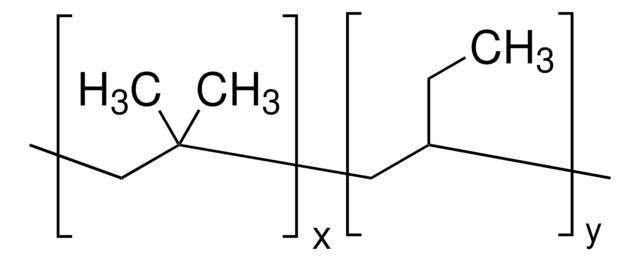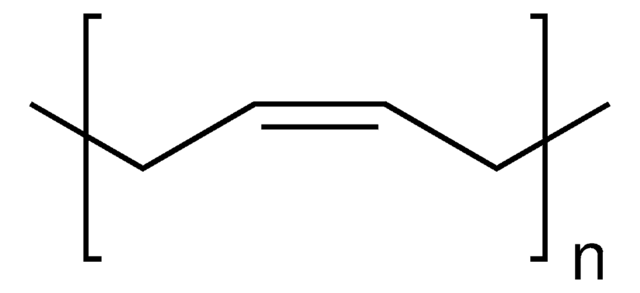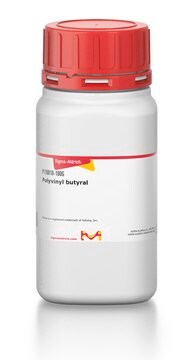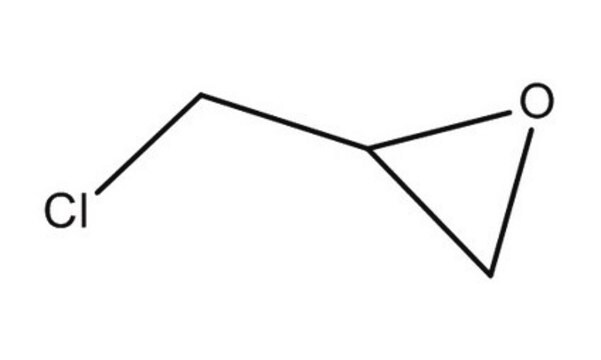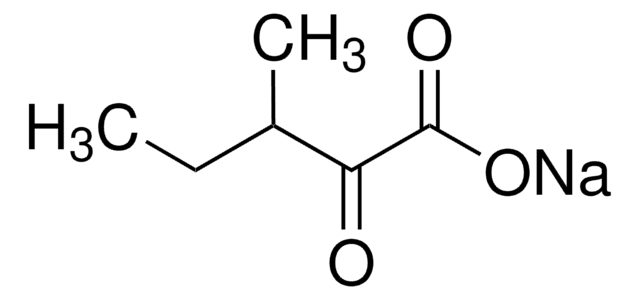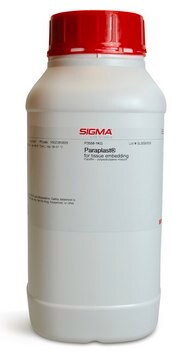181463
Polyisobutylene
average Mw ~1,000,000, average Mn ~600,000 by GPC/MALLS, average Mv ~1,200,000
Sign Into View Organizational & Contract Pricing
All Photos(1)
About This Item
Linear Formula:
[CH2C(CH3)2]n
CAS Number:
MDL number:
UNSPSC Code:
12162002
PubChem Substance ID:
NACRES:
NA.23
Recommended Products
form
solid (or Chunk(s))
mol wt
average Mn ~600,000 by GPC/MALLS
average Mv ~1,200,000
average Mw ~1,000,000
contains
500 ppm BHT as stabilizer
color
colorless, or white
refractive index
n20/D 1.51
density
0.92 g/mL at 25 °C (lit.)
SMILES string
CC(C)=C
InChI
1S/C4H8/c1-4(2)3/h1H2,2-3H3
InChI key
VQTUBCCKSQIDNK-UHFFFAOYSA-N
Looking for similar products? Visit Product Comparison Guide
Application
- The use of polyisobutylene-based polymers in ophthalmology: Discusses the application of polyisobutylene-based polymers in ophthalmologic devices, highlighting its potential in biomedical applications (L Pinchuk, 2022).
- Synthesis of a polyisobutylene-tagged fac-Ir (ppy) 3 complex and its application as recyclable visible-light photocatalyst in a continuous flow process: Presents a novel use of polyisobutylene as a support for photocatalysts, enhancing recyclability and efficiency in light-driven chemical reactions (D Rackl, P Kreitmeier, O Reiser, 2016).
- Polyisobutylene-based thermoplastic elastomers for manufacturing polymeric heart valve leaflets: In vitro and in vivo results: Explores the use of polyisobutylene-based elastomers in the production of heart valve leaflets, assessing their physical properties and compatibility (E Ovcharenko et al., 2019).
- Polyisobutylene—new opportunities for medical applications: Reviews the potential of polyisobutylene in various medical applications, focusing on its properties and benefits for healthcare materials (D Barczikai et al., 2021).
- Homogeneous and heterogeneous catalysts for the synthesis of highly reactive polyisobutylene: discovery, development and perspectives: Discusses advancements in catalyst technology for producing high-reactivity polyisobutylene, crucial for high-performance materials (IV Vasilenko, SV Kostjuk, 2021).
Storage Class Code
10 - Combustible liquids
WGK
WGK 3
Flash Point(F)
Not applicable
Flash Point(C)
Not applicable
Personal Protective Equipment
dust mask type N95 (US), Eyeshields, Gloves
Choose from one of the most recent versions:
Already Own This Product?
Find documentation for the products that you have recently purchased in the Document Library.
Customers Also Viewed
C Götz et al.
Journal of the mechanical behavior of biomedical materials, 10, 206-215 (2012-04-24)
This study examines the morphology, thermal, quasi-static and long-term dynamic creep properties of one linear and three arborescent polyisobutylene-based block copolymers (L_SIBS31, D_IBS16, D_IBS27 and D_IBS33). Silicone rubber, a common biopolymer, was considered as a benchmark material for comparison. A
Hong Seok Choi et al.
Langmuir : the ACS journal of surfaces and colloids, 28(1), 849-854 (2011-11-25)
The optical properties of polymeric materials, such as transmission loss and the thermo-optic coefficient, determine their utility in numerous applications, ranging from nanotechnology to the automotive and aerospace industries. However, because of the wide variation in the physical properties of
Ivan Yu Eremchev et al.
Physical chemistry chemical physics : PCCP, 13(5), 1843-1848 (2010-12-25)
Numerous experiments have shown that the low-temperature dynamics of a wide variety of disordered solids is qualitatively universal. However, most of these results were obtained with ensemble-averaging techniques which hide the local parameters of the dynamic processes. We used single-molecule
Deniz C Tuncaboylu et al.
Langmuir : the ACS journal of surfaces and colloids, 26(10), 7574-7581 (2010-01-29)
Organic-inorganic hybrid materials attract particular interest because of their excellent mechanical properties. Here, we report the synthesis of hybrid cryogels consisting of interpenetrated polyisobutylene and silica networks. The gels were prepared by cross-linking of butyl rubber in cyclohexane containing silica
Corinne Vebert-Nardin
Chimia, 65(10), 782-786 (2011-11-08)
With this article, we wish to give an overview of our main research activities assessing the potential of a suitable polymer modification of DNA fragments to self-assemble biologically active nanostructures. Specifically, the grafting of a hydrophobic polymer segment on DNA
Our team of scientists has experience in all areas of research including Life Science, Material Science, Chemical Synthesis, Chromatography, Analytical and many others.
Contact Technical Service
